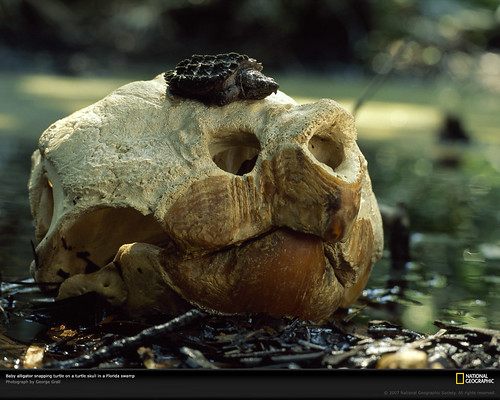

“When something does not insist on being noticed, when we aren’t grabbed by the collar or struck on the skull by a presence or an event, we take for granted the very things that most deserve our gratitude”
— Cynthia Ozick

” A baby alligator snapping turtle in a Florida swamp perches on the outsize skull of a record-breaking ancestor. At its largest, the monstrous reptile weighed a whopping 250 pounds (113 kilograms). With its spiked shell, beak-like jaws, and thick, scaled tail, this species is often referred to as the “dinosaur of the turtle world.”
(Photo shot on assignment for, but not published in, “Swamp Thing: Unmasking the Snapping Turtle,” March 1999, National Geographic magazine)”

**Via ehow Male alligator snapping turtles weigh between 155 and 175 pounds when fully grown. They are the largest known freshwater turtle and are often compared with dinosaurs because of their primitive-like appearance. They have large heads with strong, beak-like jaws and spiky ridges running along their shell. They live in deep, muddy holes in the rivers and streams of the southeastern part of the United States. They are most at home in the water.
- Habitat : Alligator turtles make their home in the waterways that empty into the Gulf of Mexico. They remain almost motionless in the water and stay submerged for 40 to 50 minutes at a time. Algae often grow on their shells, which makes them invisible to marine life and allows them to snatch prey that wanders close. Females nest on land and, on occasion, males will bask in the sun. Young turtles live in small steams.
- Diet : Alligator snapping turtles in captivity are fed fish, mice, worms and a nutritionally balanced diet. Wild turtles usually hunt and feed nocturnally. They like to eat all types of fish, clams, worms, aquatic plants, frogs, snakes, snails and other turtles. Their bright red, worm-shaped tongues are like magnets to their prey and make hunting simple for the turtle because marine life is attracted to the color and motion of the tongue.
- Reproduction : Mating occurs in the early spring in Florida and late spring in the Mississippi Valley. The male grasps the female’s shell from behind when he inseminates her. Nesting takes place in the sand one to two months later and incubation takes up to 4 1/2 months before hatching occurs.
- Life Span : Incubation temperature determines the sex of the hatchlings, which arrive in autumn and are born looking like adult turtles. Sexual maturity comes between the 11th and 13th year into their long life span, which ranges from 20 to 70 years in captivity. Their only predators are human, who harvest them for their meat or keep them in captivity as pets and for their own amusement.
- Threats : Dam construction, river flooding, dredging and over-harvesting all threaten the alligator turtle population. Preserving their habitat can be achieved by protecting wetlands and streams through land and easement acquisition. Additional harvesting regulations by the federal government and less carelessness by the boating and fishing community would also help protect the turtles.

Links of note ::
- Sea Turtle Conservancy : Adopt – a – Turtle
- The Lake Jackson Ecopassage, the interesting history of this part of Florida & the “highest mortality road-kill rate in the world” of Snappers, Turtles, and other wetland wildlife – and the Lake Jackson Ecopassage Alliance‘s 10 + year solution project. ** Graphic images of actual road-killed and injured animals. Warnings are posted and hidden until scrolled-over to be revealed, however some images may not be suitable for all viewers.
~ t

